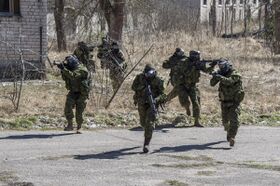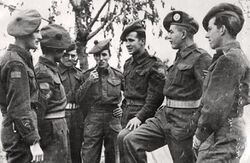Erebonian and Rubrumian Army Corps: Difference between revisions
No edit summary |
|||
| (7 intermediate revisions by 2 users not shown) | |||
| Line 1: | Line 1: | ||
{{Template:WIP}} | |||
[[Category:Lucis Commonwealth/Commonwealth of Nations]] | |||
[[Category:Lucis Commonwealth Army Formations, Units and Divisions]] | |||
{{Infobox military unit | {{Infobox military unit | ||
|unit_name=Erebonian and Rubrumian Army Corps | |unit_name=Erebonian and Rubrumian Army Corps | ||
|image= | |image= [[File:ERUACExercise.jpg|280px]] | ||
|caption= | |caption= A joint Erebonian and Rubrumian reconnaissance team on exercise, 2015 | ||
|country= {{flagicon image|Erebonian Flag.jpg|22px}} [[Erebonian Empire]]<br/> {{flagicon image|Flag of Rubrum1 T E.jpg|22px}} [[Rubrum and the Peristylium|Rubrum]]<br/> | |country= {{flagicon image|Erebonian Flag.jpg|22px}} [[Erebonian Empire]]<br/> {{flagicon image|Flag of Rubrum1 T E.jpg|22px}} [[Rubrum and the Peristylium|Rubrum]]<br/> | ||
|allegiance={{flagicon image|Erebonian Flag.jpg|22px}} [[ | |allegiance={{flagicon image|Erebonian Flag.jpg|22px}} [[Imperial Army of Erebonia]]<br/> {{flagicon image|Flag of Rubrum1 T E.jpg|22px}} [[Rubrumian Armed Forces]]<br/> | ||
|dates= 1912 - Present | |dates= 1912 - Present | ||
|branch= | |branch= | ||
| Line 40: | Line 43: | ||
===Second Europan War=== | ===Second Europan War=== | ||
[[File:ErebonianandRubrumianEWII.jpg|thumb|left|250px|Erebonian troops of the [[Arseid and Sutherland Highlanders of Erebonia]] chatting with Rubrumian troops of the [[Argyll and Sutherland Highlanders of Rubrum]], 1942]] | |||
At the start of the [[Second Europan War]], one of the first nations to react in sending reinforcements to Erebonia was Rubrum. The declaration of war by the [[Autocratic East Europan Imperial Alliance]] to Erebonia caused the [[Erebonian-Rubrumian Defence Treaty of 1920]] to take in full effect. In 1935, majority of Lucis Commonwealth forces were comprised of Rubrumians. At the start of the war, there were about 250,000 Rubrumian troops who fought in the [[Scandinavian Campaign]] and by the end of the war, the number grew to 950,000. Rubrum in effect had contributed the most support in manpower and equipment to Erebonia during the war. | |||
By 1938, Allied High Command in the [[Middle East Campaign]] were badly begging for additional manpower and support, especially as the pivotal [[Battle of Sania]] was taking place during this time. Conflicts arose as to which formation would be sent to the Middle East. Agreements would not come to a close until in the spring of 1939, during which at that time, the [[Battle of Sania]] was a victory for the Allies. The decision was to have a joint Erebonian and Rubrumian force that would set foot in the Middle East. With this, the [[Second Erebonian and Rubrumian Imperial Force]] was created with two co-commanders, Generals [[Elliot Testarossa]] and [[Brian Regnitz]]. The force was an amalgamation of the [[VII Erebonian Corps]] under the command of Regnitz and the [[III Rubrumian Corps]] under the command of Testarossa. This was the only time that Erebonia fought overseas during the war. The formation would prove to serve from the Middle East up to the [[Asianna and the Pacific Campaign]], culminating in the [[Operation Arbiter|landlocked Allied invasion of Quenmin]] and in the [[Central Highlands Campaign]], where the mountaineer traits of the Erebonians and the instinctive flexibility of the Rubrumians would prove invaluable. | |||
===War of Lorican Aggression=== | ===War of Lorican Aggression=== | ||
| Line 48: | Line 57: | ||
==Order of Battle== | ==Order of Battle== | ||
==Quotes== | |||
*''I would fear Erebonian and Rubrumian troops than a typical Imperial soldier. '' | |||
— Calvardian Generalfeldmarschall [[Thomas Welkenberg]], 1940. | |||
*''Next to the ZANACs, those (ERUAC) troops will win a battle for you in a blink of an eye. '' | |||
— Archadian Major General [[Giovanni Filiberto]], 1940 | |||
*''One of the most elite formations of the Commonwealth. if we had them on our side, we could have won the war in at least a year. '' | |||
— Archadian Field Marshal [[Victor Sazabio]], 1940 | |||
*''One of the most formidable and relentless attacks that I ever faced are from them (ERUAC troops). '' | |||
— Quenminese General [[Vương Thị Lệ]], 1940 | |||
*''They are brave, committed men, and I respect them for that.'' | |||
— Quenminese General [[Kiều Dũng Quang]], 1941 | |||
*''You know. If our men were to fight like them, we would've conquered the world.'' | |||
— Quenminese Imperial Marshal [[Thạch Hung Sõn Chiến]] to Lệ and Quang, 1945. | |||
*''They sure know how make a fight worth watching. I thank them for serving as an inspiration for making my troops fight with rigor and resolve.'' | |||
— Bethausian General [[Zaw Sein Arkar]], 1946. | |||
Latest revision as of 14:26, 23 February 2021
This article is incomplete because it is pending further input from participants, or it is a work-in-progress by one author. Please comment on this article's talk page to share your input, comments and questions. Note: To contribute to this article, you may need to seek help from the author(s) of this page. |
| Erebonian and Rubrumian Army Corps | |
|---|---|
 A joint Erebonian and Rubrumian reconnaissance team on exercise, 2015 | |
| Active | 1912 - Present |
| Country | |
| Allegiance | |
| Type | Combined Headquarters |
| Role | Theater of Operations |
| Size | 5 Divisions 5 Independent Brigades |
| Part of | Lucis Commonwealth Armies in Erebonia |
| Garrison/HQ | Fort Daidoji, Leeves, Erebonian Empire |
| March | Dambuster's March Panzerlied |
| Engagements | First Europan War Second Europan War War of Lorican Aggression Post-War of Lorican Aggression Crisis Second Lucis Civil War Imperial Crisis |
| Commanders | |
| Current commander | Olaf Craig |
| Ceremonial chief | Magnus Akselsen |
| Colonel of the Regiment | Erwin Neithardt |
| Notable commanders | David Philipp Schwimmer Daidoji Kitagawa Karl L.K. Arseid |
The Erebonian and Rubrumian Army Corps (ERUAC) is an army formation based in both the Erebonian Empire and Rubrum. It was formed in 1912 as a contingency to counter the threat posed by the Autocratic East Europan Imperial Alliance and the Calvard Republic. The corps traces its origins from West Erebonia, during which it was under Lucian Administration as the Dominion of Erebonia. During that year, there were not enough troops from the UK to strengthen the defences on Western Erebonia so it was decided that troops from Rubrum would form up.
Throughout history, the relations between Rubrum and the Erebonian would root its strong ties from the army corp. Given that the cultures of the two countries are almost similar such as possessing a common form of English language and accent, as well as almost being similarly rooted from the Lucian Culture; the peoples of the two countries consider themselves more than a sibling despite Erebonia never being fully under Lucian Administration or a colony. This special relationship is still evident today, with Rubrum being the Erebonia's strongest trading, innovation, and investment partner. Exercises in the form of the Army Corps are still being conducted today.
The Army Corps would serve throughout the 20th Century and into the modern era. The formation of the Army Corps on 15 May is celebrated as Eruac Day, as well as the Erebonia-Rubrum Friendship Day.
Background
Formation
Operational History
First Europan War
Second Europan War

At the start of the Second Europan War, one of the first nations to react in sending reinforcements to Erebonia was Rubrum. The declaration of war by the Autocratic East Europan Imperial Alliance to Erebonia caused the Erebonian-Rubrumian Defence Treaty of 1920 to take in full effect. In 1935, majority of Lucis Commonwealth forces were comprised of Rubrumians. At the start of the war, there were about 250,000 Rubrumian troops who fought in the Scandinavian Campaign and by the end of the war, the number grew to 950,000. Rubrum in effect had contributed the most support in manpower and equipment to Erebonia during the war.
By 1938, Allied High Command in the Middle East Campaign were badly begging for additional manpower and support, especially as the pivotal Battle of Sania was taking place during this time. Conflicts arose as to which formation would be sent to the Middle East. Agreements would not come to a close until in the spring of 1939, during which at that time, the Battle of Sania was a victory for the Allies. The decision was to have a joint Erebonian and Rubrumian force that would set foot in the Middle East. With this, the Second Erebonian and Rubrumian Imperial Force was created with two co-commanders, Generals Elliot Testarossa and Brian Regnitz. The force was an amalgamation of the VII Erebonian Corps under the command of Regnitz and the III Rubrumian Corps under the command of Testarossa. This was the only time that Erebonia fought overseas during the war. The formation would prove to serve from the Middle East up to the Asianna and the Pacific Campaign, culminating in the landlocked Allied invasion of Quenmin and in the Central Highlands Campaign, where the mountaineer traits of the Erebonians and the instinctive flexibility of the Rubrumians would prove invaluable.
War of Lorican Aggression
Second Lucis Civil War
Imperial Crisis
Order of Battle
Quotes
- I would fear Erebonian and Rubrumian troops than a typical Imperial soldier.
— Calvardian Generalfeldmarschall Thomas Welkenberg, 1940.
- Next to the ZANACs, those (ERUAC) troops will win a battle for you in a blink of an eye.
— Archadian Major General Giovanni Filiberto, 1940
- One of the most elite formations of the Commonwealth. if we had them on our side, we could have won the war in at least a year.
— Archadian Field Marshal Victor Sazabio, 1940
- One of the most formidable and relentless attacks that I ever faced are from them (ERUAC troops).
— Quenminese General Vương Thị Lệ, 1940
- They are brave, committed men, and I respect them for that.
— Quenminese General Kiều Dũng Quang, 1941
- You know. If our men were to fight like them, we would've conquered the world.
— Quenminese Imperial Marshal Thạch Hung Sõn Chiến to Lệ and Quang, 1945.
- They sure know how make a fight worth watching. I thank them for serving as an inspiration for making my troops fight with rigor and resolve.
— Bethausian General Zaw Sein Arkar, 1946.